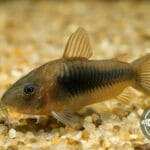Intrigued by the fahaka puffer, the king of the freshwater aquarium? These intelligent, unique, and captivating fish demand respect and specialized care. This comprehensive guide dives deep into every aspect of fahaka puffer ownership, equipping you with the knowledge to provide a thriving environment for these fascinating creatures. From tank setup and water parameters to their carnivorous diet and potentially grumpy personality, we’ll cover everything you need to know. So, if you’re ready to embark on this rewarding, albeit demanding, journey, let’s explore the world of the fahaka puffer.
Creating a Puffer Paradise: The Ideal Tank Setup
Imagine designing a slice of the Nile River, tailored specifically for your fahaka puffer. These fish can reach a surprising 18 inches in length, transforming from adorable juveniles into tank-dominating adults sooner than you might think. Therefore, a spacious tank is non-negotiable. A minimum of 120 gallons is recommended for a single adult, with larger tanks (200+ gallons) offering even more room to thrive. For more adorable and smaller fish, discover the world of Chili Rasboras. Check out their captivating schooling behavior!
Essential Tank Components
- Filtration: Fahaka puffers are messy eaters, producing a substantial bioload. Robust filtration, capable of turning over the tank’s volume multiple times per hour, is essential for maintaining pristine water quality. Invest in both mechanical and biological filtration for optimal results.
- Substrate: Sand or fine gravel is ideal, providing a comfortable surface for your puffer to explore and exhibit natural behaviors like digging.
- Decor: Rocks, driftwood, caves, and even PVC pipes create a stimulating environment and offer essential hiding spots. These structures help reduce stress and aggression, contributing to a healthier and happier puffer. Sturdy live plants can add a touch of natural beauty, but be prepared for some potential nibbling or uprooting.
Mastering Water Chemistry: The Goldilocks Zone
Fahaka puffers thrive in stable, slightly alkaline water conditions. Aim for a pH between 7.5 and 8.2 and a temperature between 78-82°F (25-28°C). Avoid sudden temperature fluctuations, as these can stress your puffer. Regular 25% weekly water changes are crucial for maintaining optimal water quality, mimicking the natural refreshing flow of their native river environment. These fish are particularly sensitive to soft water, so maintaining the proper hardness (10-15 dGH) is crucial.
Feeding Your Finned Carnivore: A Crunchy Culinary Experience
Forget fish flakes! Fahaka puffers are dedicated carnivores, equipped with powerful beak-like jaws designed for crushing. Their diet should consist primarily of hard-shelled foods:
- Snails: A staple food and a favorite treat, especially mystery snails.
- Shellfish: Mussels, clams, and other shellfish provide essential nutrients.
- Crustaceans: Crabs, crayfish, and shrimp offer variety and keep those jaws working.
- Small Fish (Occasionally): While not a primary food source, the occasional small fish can be offered as a supplemental treat. However, feeder fish should be avoided due to the risk of introducing parasites and diseases.
This specialized diet not only satisfies their nutritional needs but also plays a vital role in maintaining their beak. Hard-shelled food helps wear down their constantly growing beak, preventing overgrowth, which can interfere with their ability to eat. Feed your puffer a few times a week, adjusting the frequency and amount based on their individual size, age, and appetite.
Decoding the Puffer Personality: A Solitary Soul
Fahaka puffers are known for their solitary nature and can be quite territorial. They are not community fish and are prone to aggression, particularly towards other fish, regardless of size. While some individuals may tolerate large, robust tank mates in exceptionally spacious aquariums, this is risky and requires constant monitoring. Even hardy invertebrates are likely to become snacks. A species-only tank is generally the safest and most humane option.
While fahaka puffers can learn to recognize and even interact with their owners, they are not cuddly pets. Avoid handling them, as they can deliver a painful bite with their powerful beaks. Handling also causes them stress, which can negatively impact their health.
A Long-Term Commitment: Lifespan and Growth
With proper care, a fahaka puffer can live for 10 years or more. They experience rapid growth, particularly in their first few years, eventually reaching up to 18 inches in length. This significant size and long lifespan underscore the commitment required for responsible fahaka puffer ownership. Are you prepared to provide consistent, specialized care for the next decade?
Are Fahaka Puffers Aggressive?
Yes, fahaka puffers are inherently aggressive and territorial. It’s not recommended to pair them with any other fish species, as tensions are bound to arise. Avoid petting or attempting to play with them, no matter how cute they might seem. While individual temperaments can vary, the inherent predatory instincts of fahaka puffers represent a significant risk to tank mates. Successful fahaka puffer keeping requires a large, species-only tank, diligent maintenance, and a deep understanding of their specific needs.
How Big Do Fahaka Puffer Fish Get?
Fahaka puffers can reach an impressive size, often exceeding the commonly cited 15 inches and reaching up to 18 inches in length under optimal conditions. This makes them the second-largest freshwater pufferfish (after the Mbu puffer). This considerable size necessitates a large aquarium (120 gallons minimum, larger preferred) and specialized care. Understanding the potential size of a fahaka puffer is crucial for successful long-term care, as inadequate tank size can hinder growth and compromise their well-being. Factors like diet, water quality, tank size, and genetics can influence their growth.
Are Fahaka Puffers Hard to Keep?
Fahaka puffers are not for beginners. Their demanding needs, substantial size, specialized diet, and aggressive temperament require an experienced aquarium keeper. A 120+ gallon tank is the bare minimum, and a species-only setup is often the best choice due to their solitary nature and aggression. Their diet must consist primarily of hard-shelled foods like snails, crustaceans, and mussels to maintain their beak. While rewarding, fahaka puffer care presents a significant financial and time commitment.
Looking for a different kind of companion? Discover the adorable and hypoallergenic world of F1BB mini Goldendoodles and their charming personalities.
















3 thoughts on “The Definitive Guide to Fahaka Puffer Fish: Expert Advice on Care, Tank Setup, and Responsible Ownership”
Comments are closed.